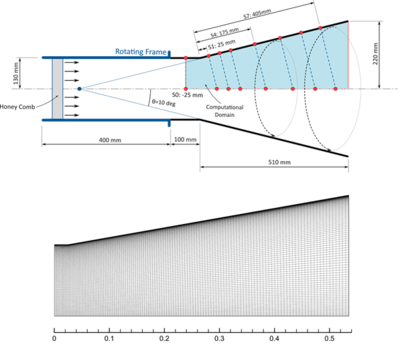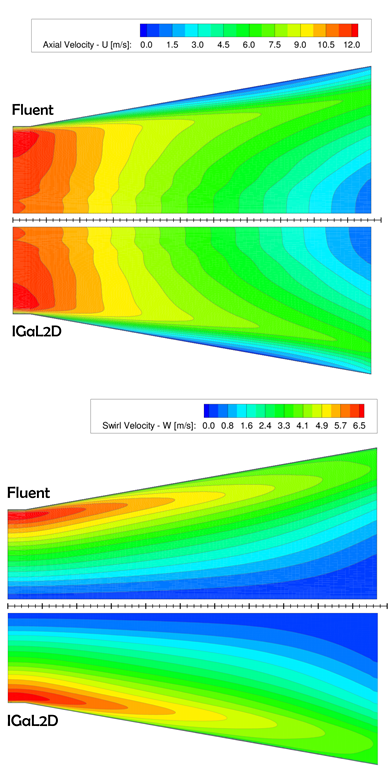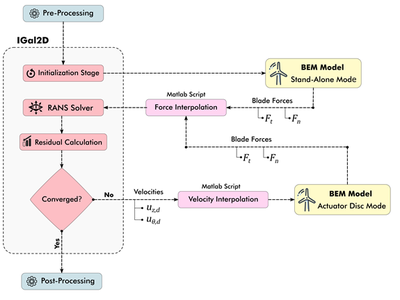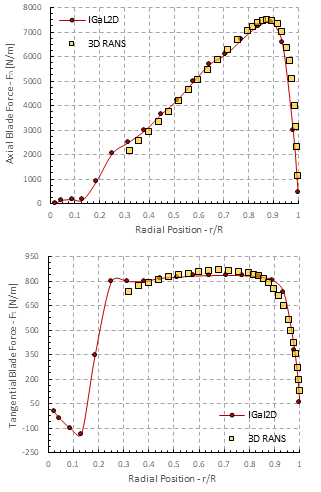IGal2D is a Computational Fluid Dynamics (CFD) solver, developed by members of the Turbomachines & Fluid Dynamics Laboratory (TurboLab-TUC), which has been specially designed for the numerical prediction of incompressible 2D & 2D axisymmetric flows that involve swirling motion. The current version of IGal2D solver has been implemented in FORTRAN 90 programming language and relies on the combination of the Artificial Compressibility Method (ACM) with an axisymmetric formulation of the Reynolds-Averaged Navier-Stokes (RANS) equations. In particular, the governing equations have been arranged in a pseudo-Cartesian formulation and enhanced by the addition of the circumferential momentum equation. The discretization of spatial derivative terms within the governing equations is performed via unstructured two-dimensional grid layouts, by employing a node-centered Finite-Volume (NCFV) scheme. For the evaluation of inviscid fluxes, the upwind Roe approximate Riemann solver is applied, coupled with a higher-order accurate spatial reconstruction, whereas an element-based approach is used for the calculation of gradients required for the viscous fluxes. Time integration is succeeded through a second-order accurate four-stage Runge-Kutta method, adopting a local time-stepping technique. Moreover, the current version of IGal2D solver also features a time-saving agglomeration multigrid scheme, which incorporates the full approximation scheme in a V-cycle process, within an efficient edge-based data structure. IGal2D provides the option of imposing four different types of boundary conditions: solid wall, symmetry, inlet and outlet types of boundaries, while the user can select between the SST k-ω and standard k-ω models for modeling turbulence. The coupling of the flow and turbulence models is achieved by adopting a so-called loose coupling approach, where the partial differential equations (PDEs) defining the flow and turbulence models are resolved separately at each pseudo-time step, with the interaction between them to be realized by means of the turbulent kinetic viscosity and velocity components. All the interactions between the user and IGal2D software are performed by properly designed text files. Finally, IGal2D solver can be executed either in a stand-alone mode or in combination with the also in-house developed BEM-TUC code, within the framework of a RANS-BEM simulation for the performance prediction of wind turbine rotors.
References:
S.N. Leloudas, G.N. Lygidakis, G.A. Strofylas, I.K. Nikolos, "Aerodynamic Shape Optimization of Diffuser Augmented Wind Turbine Shrouds Using Asynchronous Differential Evolution", Proceedings of the ASME International Mechanical Engineering Congress and Exposition, IMECE 2018, 9-15 November, 2018, Pittsburgh, PA, USA, Paper No. IMECE2018-86820. https://doi.org/10.1115/IMECE2018-86820
S.N. Leloudas, A.I. Eskantar, G.N. Lygidakis, I.K. Nikolos, "Low Reynolds Airfoil Family for Small Horizontal Axis Wind Turbines Based on RG15 Airfoil", SN Applied Sciences, 2, 371, 2020. https://doi.org/10.1007/s42452-020-2161-1
S.N. Leloudas, G.N. Lygidakis, A.I. Eskantar, I.K. Nikolos, "A Robust Methodology for the Design Optimization of Diffuser Augmented Wind Turbine Shrouds", Renewable Energy, 150, pp. 722-742, 2020. https://doi.org/10.1016/j.renene.2019.12.098
G.N. Lygidakis, S.N. Leloudas, A.I. Delis, I.K. Nikolos, "Prediction of Turbulent Axisymmetric Flows Using an Artificial Compressibility Approach", Proceedings of Global Power and Propulsion Society, ISSN-Nr: 2504-4400, GPPS Chania20, Chania, Greece, 7 – 9 September, 2020. Paper No.: GPPS-CH-2020-0098. DOI: 10.33737/gpps20-tc-98
S.N. Leloudas, G.N. Lygidakis, A.I. Delis, I.K. Nikolos, "An Artificial Compressibility Method for Axisymmetric Swirling Flows", Engineering Computations, 38(10), pp. 3732-3767, 2021. https://doi.org/10.1108/EC-10-2020-0594
Numerical Applications and Simulations




